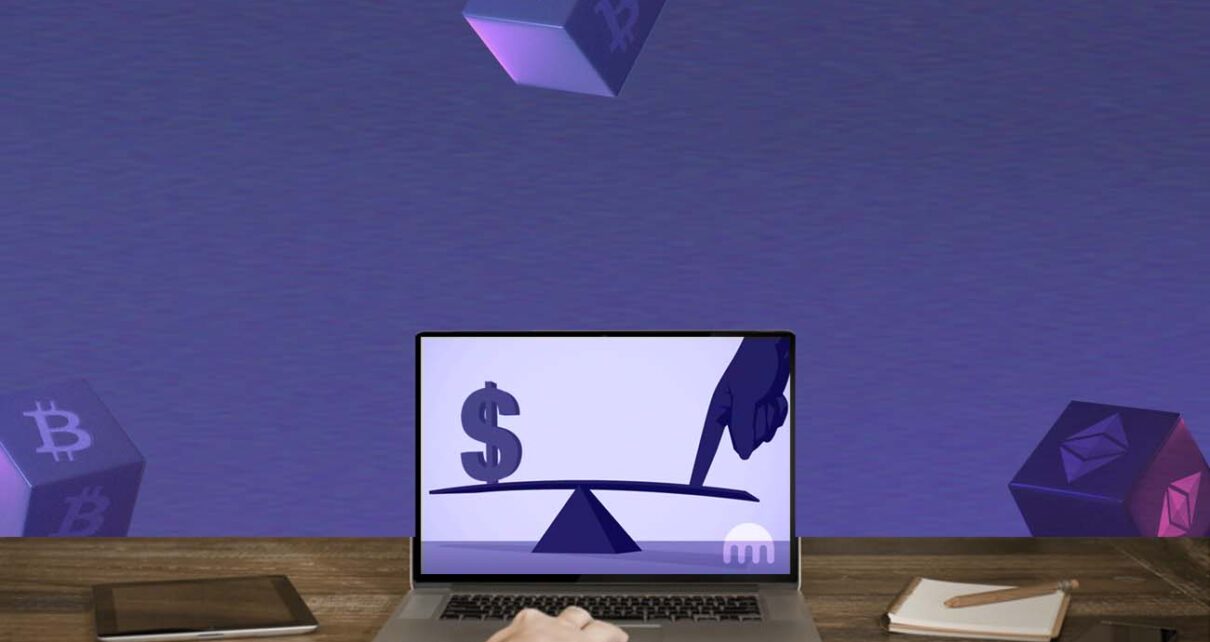
Using the Kraken trading platform, we consider margin and leverage in real investments on bitcoins. In this way we learn what these financial terms mean. Moreover, we provide the details of all the fees that are paid in the process.
Using the Kraken trading platform, we consider margin and leverage in real investments on bitcoins. In this way we learn what these financial terms mean. Moreover, we provide the details of all the fees that are paid in the process.
To understand the essence of margin and leverage, I'm going to consider two real investments on bitcoins; however, you should keep in mind that these financial terms are not exclusive to the cryptocurrency market. In one investment I will lose money. In the other, I will earn enough to make up for that loss. A summary of this article with some extra info appears in the following video:
On February 08th, 2021, when the price of bitcoins was around 47,000 USD, I forecast an upward trend that would lead to a new historical record of bitcoins. This forecast was recorded on my Twitter account:
Unluckily for me, on that date, all my money was already invested in different assets and I only had left 327.56 USD. I wished I could have more, but how could I make it happen? Actually, there was a way... requesting a loan from Kraken itself!
1. How did I lose money on Kraken?
On February 10th, 2021, my account balance was as follows:
As shown in Table II, adding dollars and bitcoins, I had a total of 457.19 USD. This amount, when one wants to request a loan, is what is called the initial margin, that is, the margin is the available money that one has to guarantee a loan. As you can see, the initial margin not only includes the available dollars but also adds bitcoins. In general, anything that is part of the initial margin is called a collateral, but looking at Table II, you may be wondering: "Why link is not included as collateral?" In the particular case of Kraken, collateral coins are listed in its website and link is not part of them, that is, if one has a lot of money invested in link, it won't affect the initial margin. In my case, this is great because in Kraken almost all of my investment is in link, see Table II, where I have hidden the value of link. But why this is great to me? Well, although this implies that Kraken will lend me a smaller amount of money, it also implies that if the scenario is adverse and I can't pay back the loan, the money invested in link will not be touched, so the most that I can lose is given by the bitcoins and the dollars that I have. In this sense, you should note that my investment strategy focuses on risking only the "leftovers" of my account.
Having 457.19 USD, how much money can I borrow? Kraken, in particular, can give you up to 5 times your initial margin, that is, I will be able to get a max loan of 457.19 x 5 = 2,285.95 USD. This is usually called a 5x leverage. In general, the leverage multiplies the initial margin to increase the volume of your investment. In my case, I opted for a 3x leverage, that is, with an initial margin of 457.19 USD, I opted for a loan of 457.19 x 3 = 1,371.57 USD. With this data, the buying and selling positions that I took were the following:
As you can see from Tables III and IV, I lost 1,325.01 - 1,371.58 = -46.57 USD on this trade. If we see it in percentages, the price of bitcoins fell by 3.39%; however, my actual loss is greater than this value. If I originally had 457.19 USD and lost 46.57 USD, then what I actually lost was 10.17%. In other words, my loss, like the leverage, also increased by 3, i.e., 3.39 x 3 = 10.17%. If I would have used a 5x leverage, my loss would have increased by 3.39 x 5 = 16.95%. You may notice that the risk is high when using leverage. But how much could I actually lose? If my loss reaches 20%, or, in other words, if it reaches a margin level of 80%, then I would receive a margin call from Kraken, that is, a warning indicating that the invested money is suffering a heavy loss and soon Kraken will no longer be able to hold my position unless I add new funds. Because Kraken will not be willing to suffer the consequences of my loss, if my loss reaches 60%, then Kraken will immediately liquidate my position, that is, they will sell the bitcoins that I bought at the market price, and from there, they will get its money back. As an example, imagine that the price of bitcoins falls from 47,296.2 USD to 37,836.96 USD. In percentages, this corresponds to a drop of 20%, but since in my case I tripled the leverage borrowing 1,371.57 USD, then it corresponds to a real loss of 60%. In this case, Kraken would liquidate my position at the value of 37,836.96 USD. If I bought 0.029 BTC, this means that the sale gives back 0.029 x 37,836.96 = 1,097.27 USD, which would give a loss of 1,097.27 - 1,371.58 = -274.31 USD. Keep in mind that Kraken will get back all the money it lent by keeping all the money from the sale and deducting 274.31 USD from the initial margin, i.e., 1,097.27 + 274.31 = 1,371.57 USD. In the case exposed in Tables III and IV there was no liquidation, the loss was 10.17% and with this my account balance became:
In Table V there are two important points to note. The first one is related with the value of bitcoins. If we compare Tables II and V we will notice that their values are different. This is natural because the price of bitcoins is constantly fluctuating and therefore the values given in the tables are only reference values. The second point is related with the value of dollars. When comparing Tables II and V, we will notice that I started with 327.56 USD and finished with 273.83 USD. This implies a loss of 53.7 USD. We initially calculated that the loss was 46.57 USD, then where did the rest come from? To understand it, let's see the transaction summary:
As we can see in Table VI, Kraken charged me, respectively, 3.70 and 3.44 USD for opening and closing my position, that is, there are fees to pay when making a margin investment. For Kraken, the buying fee corresponds to 0.27% of the total amount invested and the selling fee corresponds to 0.26% of the total amount of the sale. Keep in mind that these rates are not absolute values, they may change over time or depend on the amount invested.
2. How did I make money on Kraken?
After losing 46.57 + 3.7 + 3.44 = 53.7 USD, my account balance changed to that given in Table V. Since I was convinced that bitcoins had to grow, I did not hesitate to make a second investment. In this case, due to my initial loss I decided to risk a bit more and opted for a 5x leverage. If the initial margin on this second investment was set to 273.83 + 134.05 = 407.88 USD, then the total investment became 407.88 x 5 = 2,039.4 USD. With this data, the buying and selling positions that I took were the following:
As you can see from the tables above, I earned 2,232 - 2,039.4 = 192.6 USD on this transaction. If we see it in percentages, the price of bitcoins grew by 9.44%; however, my actual profit is higher than this value. If I originally had 407.88 USD and made 192.6 USD, then my actual profit was 47.2%. In other words, my profit, as well as the leverage, also increased by 5, i.e., 9.44 x 5 = 47.2%. You can notice that the profits are huge when using leverage. Finally the balance of my account became:
As you can see, comparing Tables V and IX, I started with 273.83 USD and finished with 447.92 USD. This implies a profit of 174.09 USD. We initially calculated that the profit was 192.6 USD, then where did the rest go? To understand it, let's see the transaction summary:
In Table X we see that Kraken charged me 5.50 USD to open the position and 5.80 USD to close it. These correspond, respectively, to 0.27% and 0.26% of the total amount invested and the total amount of the sale. Interestingly, unlike the previous case, here there is an additional charge denoted as "rollover." If we check the time when these fees were charged (first column), we can see that they were charged every 4 hours, that is, for holding the position, Kraken charged me 0.2 USD every 4 hours. In the first case there was no additional charge because I closed my position before 4 hours had elapsed, but in this case, I kept the position from February 11th to February 17th, this is equivalent to 35 times the charge of 0.2 USD, or 7.1379 USD. In general, for holding a position, Kraken charge us every 4 hours, 0.01% (up to 0.02%) of the total amount invested. In this example, this means (0.01 x 2,039.4)/100 = 0.2039 USD. Therefore, if you choose to keep a long-term position, you must be aware that every 4 hours you will be losing a small amount of money.
There are variations to the investments explained here, for example, you could have an initial margin of X dollars but choose to only use half of that. In this case, you would have an active margin of X/2 and a free margin of the same proportion. The latter, could be used in another investment. This is explained in more detail in the article: "Make money selling bitcoins without having them. Full explanation of the short position." There, I also explain how to invest in a bear market, that is, instead of requesting a loan of dollars to buy more bitcoins, I request a loan of bitcoins to sell them at a high price and buy them back at a lower price. This investment strategy in finance is called a short position. The mechanism is similar to the long position, which is the one that we have described here. If you want to know more about it, I invite you to read the aforementioned article.
Views: 1
Notifications
Receive the new articles in your email








